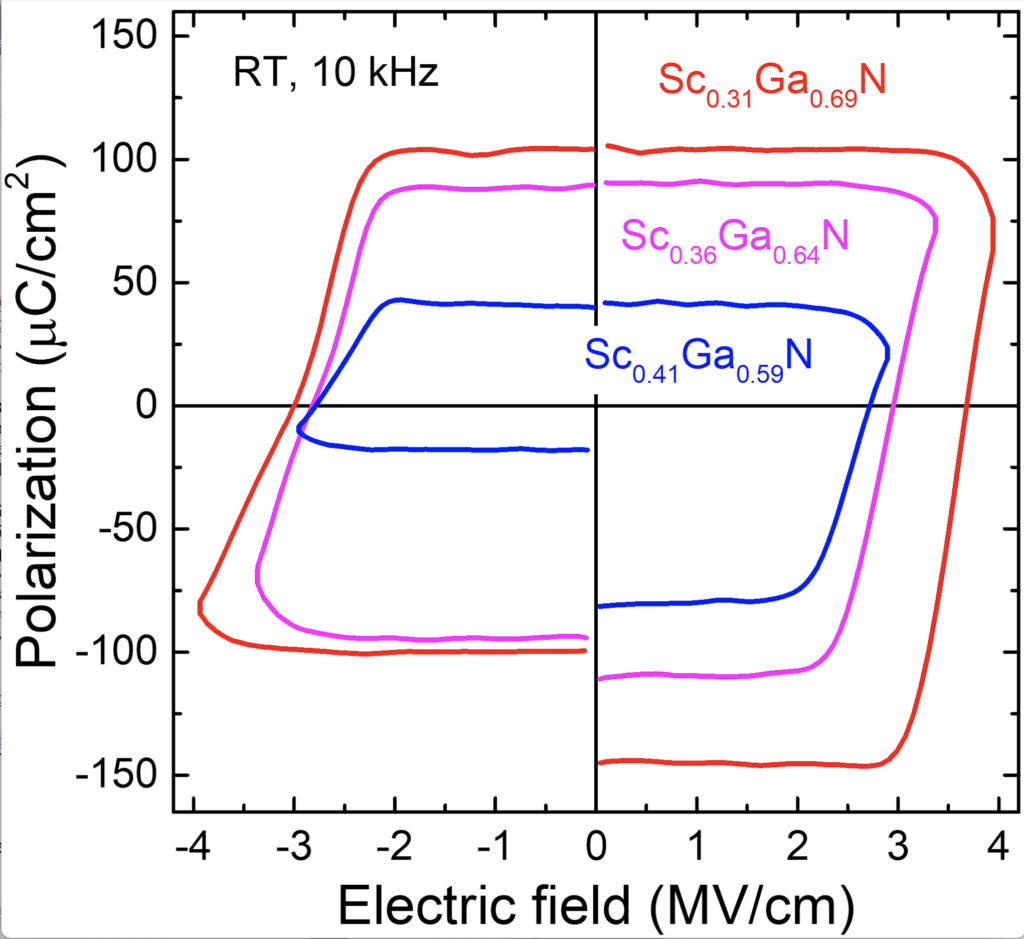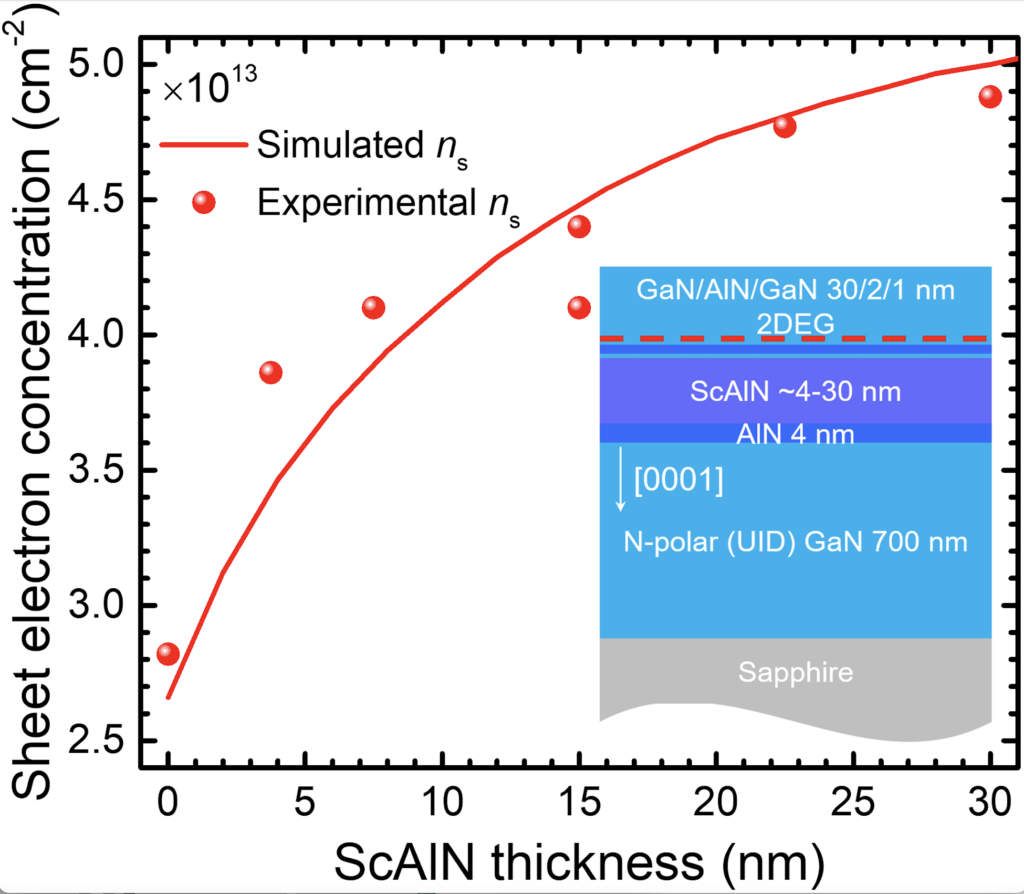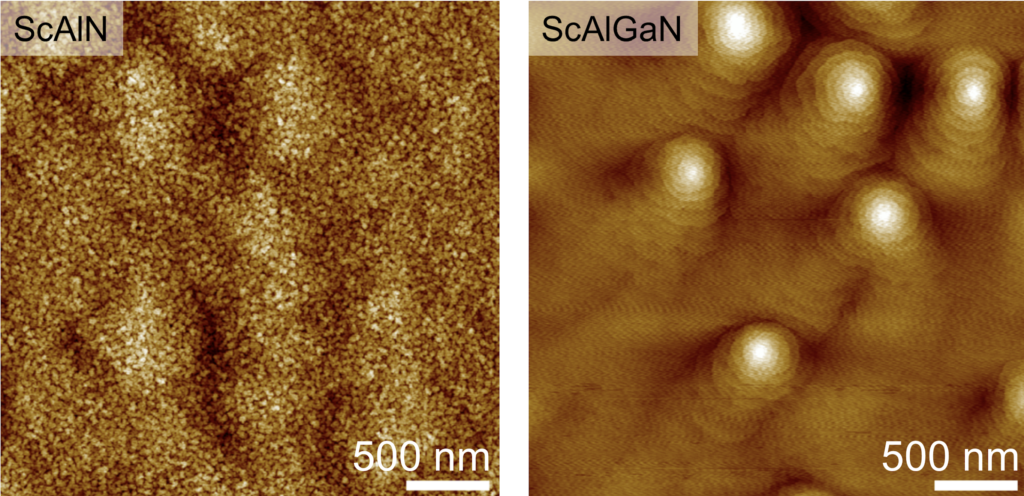Research full speed ahead on manufacturable III-V materials for next-generation electronics

Prof. Zetian Mi and his group at the University of Michigan have reported several important advancements in the area of scandium-based III-nitride materials, which could be key to a variety of next-generation nitride-based electronic, optoelectronic, photonic, piezoelectric, and ferroelectric devices.
“Fundamental research on new materials and their properties has a long history of leading to novel physical discoveries and multifunction and cross-field applications,” said postdoctoral researcher Ping Wang, a member of Prof. Zetian Mi’s group.
Mi’s group has been investigating gallium nitride (GaN) semiconductors for more than a decade, and recently achieved single-crystalline high-quality ferroelectric III-V semiconductors using molecular beam epitaxy (MBE), in collaboration with Prof. John Heron’s group in the Department of Materials Science & Engineering. Key to this breakthrough was the introduction of scandium (Sc) to the materials mix. Using MBE to grow the materials makes the process compatible with some of the mainstream manufacturing.
The addition of scandium in GaN-based materials, one of the most produced semiconductors in the world, offers a revolutionary platform for next generation high frequency/power electronics, some key technologies of 5G/6G communications, and ultraviolet optoelectronics for air/water purification, to name a few.
Zetian Mi
Following on this research, Mi’s group aimed to add the features of tunable ferroelectricity, controllable lattice-polarity, and reliable material quality to Sc-III-nitrides. Achieving these goals are key for Sc-III-nitrides to move forward from fundamental material research to industrial applications.
In the past few months, the group has published three additional articles showing continued advancements in Sc-III-nitrides, and were recently awarded two grants to help bring the technology closer to market.
Tunable ferroelectricity and switchability in III-nitrides
When Mi’s group achieved ferroelectric Sc-doped AlN (ScAlN), the material showed high temperature phase stability, large tunable coercive field, remarkable switchable polarization, extremely high Curie temperature, wide bandgap, and good compatibility with both silicon and GaN technologies.
This combination of properties in one material was previously impossible, yet still lacked a key attribute, tunability.
“Polarization is what makes III-nitrides unique, and our ability to control and switch the polarization opens up new applications in memory, reconfigurable power devices and piezo devices, as well as quantum photonic devices with unprecedented stability, performance, and functionality,” said postdoctoral researcher Ding Wang, a member of Prof. Zetian Mi’s group.

With this goal in mind, Mi’g group turned its attention to a related but less explored class of material, ScGaN, which has also been shown to have good piezoelectricity.
By tuning the amount of Sc used, they discovered a small window where they could accomplish ferroelectric ScGaN, so that the polarity can be electrically switched.
Given the widely tunable bandgap between AlN and GaN, the realization of ferroelectricity in fully epitaxial ScGaN promises a unique material platform with widely tunable ferroelectricity, polarization, and band gap. It also enables alloy, strain, interface, and quantum engineering in Sc-III-nitride materials, all of which are vital for nitride-based electronic, optoelectronic, and piezoelectric devices.
Mi’s group is the first to experimentally report on this discovery.
This research was published as Fully epitaxial ferroelectric ScGaN grown on GaN by molecular beam epitaxy, by Dr. Ding Wang, Dr. Ping Wang, Boyu Wang, and Prof. Zetian Mi, Applied Physics Letters, September 2021.
N-polar ScAlN achieved for next-generation high-frequency and high-power devices
ScAlN also shows promise as an ideal barrier layer in GaN-based high electron mobility transistors (HEMTs) to improve the operating frequency at high power; this is due to its significant spontaneous polarization.
The growth of metal-polar ScAlN and its device structures has been accomplished by Mi’s group, but these devices are not easily scaled-down for use in millimeter- and sub-millimeter-wave frequencies. Prof. Elaheh Ahmadi’s group, however, has shown scalability in N-polar GaN HEMTs.
With the goal of bringing these technologies together, Mi and Ahmadi collaborated to investigate the viability of N-polar ScAlN for use in HEMT structures.

The developed deposition strategies by Mi’s group for conventional N-polar III-nitrides were successfully transplanted to produce high-quality wurtzite phase N-polar ScAlN.
Using N-polar ScAlN, they achieved high sheet electron concentration and mobility in GaN-based HEMT structures, demonstrating its compatibility for use in next-generation high-frequency and high-power electronic devices, as well as applications requiring piezoelectricity and ferroelectricity.
Ahmadi’s and Mi’s groups are the first to experimentally report on this achievement.
The research is described in N-polar ScAlN and HEMTs grown by molecular beam epitaxy, by Dr. Ping Wang, Dr. Ding Wang, Boyu Wang, Subhajit Mohanty, Sandra Diez, Dr. Yuanpeng Wu, Dr. Yi Sun, Prof. Elaheh Ahmadi, and Prof. Zetian Mi, Applied Physics Letters, August 2021.
This article was selected as an Editor’s Pick.
Quaternary alloy ScAlGaN: A promising strategy to improve the quality of ScAlN
To satisfy the requirements for high-performance electronic and optoelectronic devices, Mi’s group has continuously been attempting to improve the material quality of ScAlN, in collaboration with Prof. Robert Hovden’s group in the Department of Materials Science & Engineering.

In what turned out to be a beautiful accident, in one of their experiments, they forgot to completely remove the residual Ga atoms before starting the ScAlN deposition. Surprisingly, this resulted in an atomically smooth surface, instead of the typical granular surface for ScAlN seen by different groups.
After repeated experiments, they found that by incorporating Ga atoms during the growth of ScAlN, thereby forming the quaternary alloy ScAlGaN, the crystal quality and surface/interface morphology can be significantly improved. It also resulted in a dramatic reduction of impurity concentration, particularly of oxygen – where there was 3-4 orders of magnitude improvement over some other ScAlN films. These fundamental improvements are crucial for Sc-III-nitrides-based device architectures, with promising future applications in photonic, optoelectronic, and ferroelectric devices.
Hovden’s and Mi’s groups are the first to experimentally report on this discovery.
The research was described in Quaternary alloy ScAlGaN: A promising strategy to improve the quality of ScAlN, by Dr. Ping Wang, Dr. Ding Wang, Yutong Bi, Boyu Wang, Jonathan Schwartz, Prof. Robert Hovden, and Prof. Zetian Mi, Applied Physics Letters, January 2022.
This article was also selected as an Editor’s Pick.
Taking the next step towards practical devices
The next step in this area of research will be to explore the fundamental parameters of Sc-III-nitrides and their applications in electronic, photonic, photovoltaic, piezoelectric, and ferroelectric devices.
Mi is collaborating with researchers at the University of Michigan and Georgia Institute of Technology (Georgia Tech) on two new research projects to explore the use of Sc-III-nitrides for electronic/acoustic devices.
Prof. Amir Mortazawi will lead the first collaborative effort to design high performance integrated millimeter wave compact resonators from ScAlN ferroelectrics. The project, funded by DARPA, aims to reach operation up to 50 GHz, while overcoming the fundamental limit of acoustic resonators’ decreasing performance at higher frequencies. The intent by DARPA is to fund “innovative approaches that enable revolutionary advances in science, materials, devices, manufacturing, and systems.”
In addition, Mi’s group is collaborating with researchers at Georgia Tech and Northrop Grumman Mission Systems in a project selected for funding by DARPA. Mi’s group will provide collaborators with MBE grown ScAlN films for multimodal high performance resonators and filters that can operate up to 18 GHz, with minimal leakage and O2 surface contamination.
“The addition of scandium in GaN-based materials, one of the most produced semiconductors in the world, offers a revolutionary platform for next generation high frequency/power electronics, some key technologies of 5G/6G communications, and ultraviolet optoelectronics for air/water purification, to name a few. We are excited about contributing to this emerging revolution.” said Mi.
Research for all three completed projects was conducted in the Lurie Nanofabrication Facility (LNF), and supported by Naval Research Office.
Structural characterization of the ScAlGaN material was led by Hovden’s group, supported by the National Science Foundation, and accomplished in the Michigan Center for Materials Characterization (MC)2.
 MENU
MENU 
